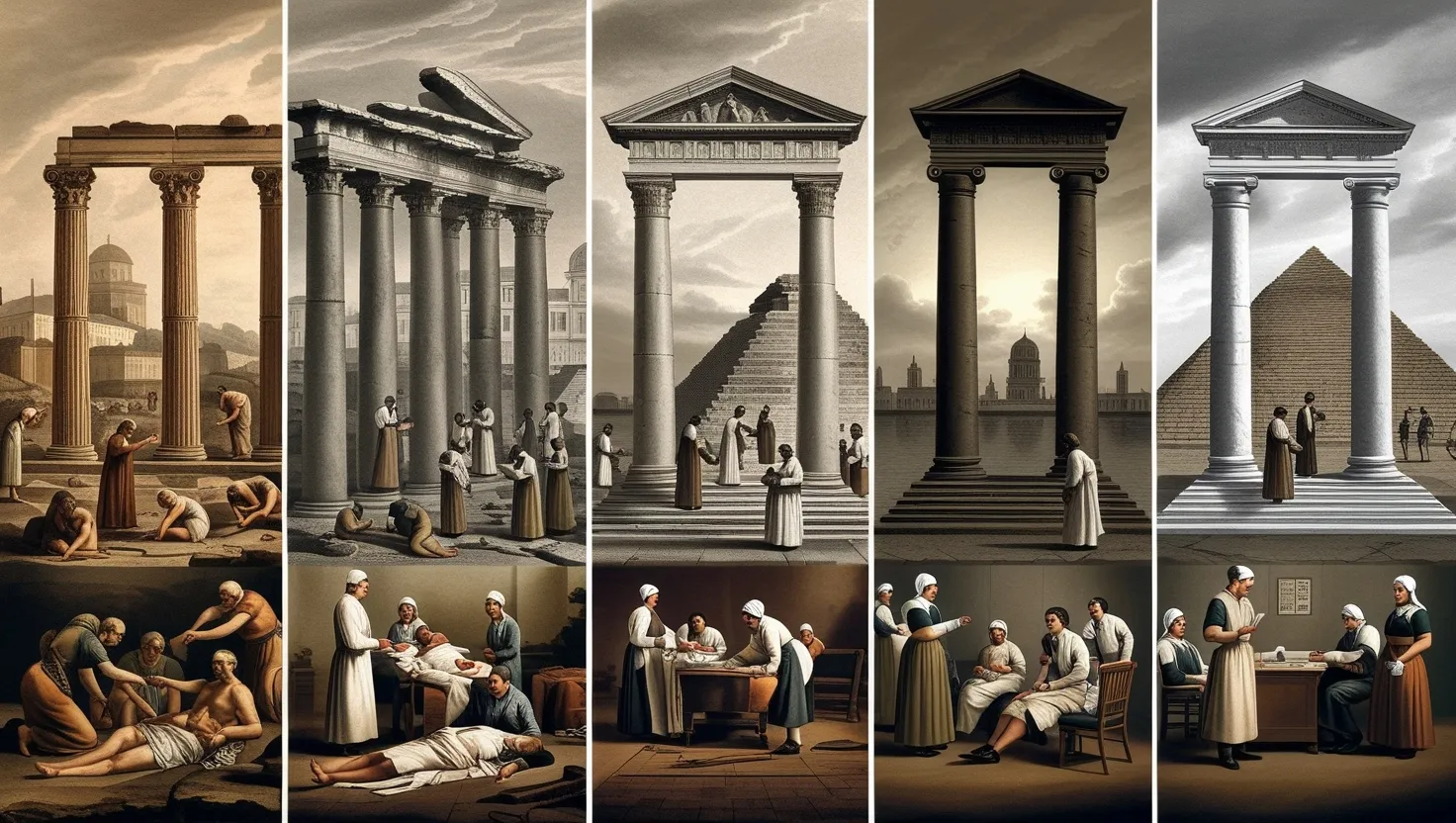5 Forgotten Pandemics That Changed Society
Throughout history, pandemics have silently reshaped civilizations, often with more profound effects than wars or political revolutions. The way disease spreads through societies reveals our interconnectedness and vulnerability as humans. I find it fascinating how these biological crises have repeatedly altered the course of history, yet many remain overlooked in our collective memory.
When we examine past pandemics, patterns emerge that help us understand our present. Disease doesn’t just claim lives—it transforms economies, shifts power balances, and rewrites cultural practices. These five forgotten pandemics demonstrate how microbes have repeatedly changed the world.
The Antonine Plague struck the Roman Empire between 165-180 CE, during what had been considered Rome’s golden age. This devastation, likely smallpox brought back by troops from campaigns in the Near East, killed approximately five million people—roughly a quarter of those infected. The timing couldn’t have been worse for Rome, coming during the final years of the Pax Romana, when the empire had reached its peak in territory, population, and influence[1].
“The wise man should consider that health is the greatest of human blessings,” wrote Hippocrates long before this plague. How true his words proved as Rome watched its strength drain away through disease.
The plague’s economic impact proved immense. Commercial activity between Rome and Asia suffered major setbacks, as shown in archaeological records of dramatically reduced trade through Egyptian ports reaching to India and Southeast Asia[1]. Labor shortages became acute, forcing increased reliance on slave labor and fundamentally altering Roman economic structures.
Have you ever wondered how a single disease could weaken an empire that had conquered most of the known world? The plague decimated Rome’s professional armies to such a degree that military offensives had to be abandoned[4]. For the first time, the empire allowed German auxiliary units to serve in the army, creating vulnerability when Germanic tribes later invaded[5]. The aristocracy suffered devastating losses, weakening governance and social cohesion throughout Roman territories.
Interestingly, while most Roman institutions suffered, religious life flourished during this crisis. People sought meaning in suffering, leading to growth in monotheistic faiths like Christianity and Mithraism[5]. This spiritual shift would eventually transform the empire’s cultural foundation.
The Plague of Justinian arrived several centuries later, between 541-549 CE, killing up to 25% of the Mediterranean population. This early bubonic plague outbreak marked the first documented appearance of Yersinia pestis in Europe. Byzantine Emperor Justinian had been on the verge of reuniting the fractured Roman Empire when disease devastated his forces and treasury.
“History is indeed little more than the register of the crimes, follies, and misfortunes of mankind,” observed Edward Gibbon. The timing of this plague certainly supports his cynical view.
The plague created catastrophic labor shortages across Byzantine territories, transforming European agricultural practices as landowners adapted to a diminished workforce. Tax revenues plummeted while military expenses remained high, creating fiscal crises. Perhaps most significantly, the resulting power vacuum facilitated the rapid rise of Islam across former Byzantine territories in the Near East and North Africa.
What economic systems might have developed if this biological disaster hadn’t occurred? The question reminds us how disease shapes options available to societies at critical junctures.
The Cocoliztli Epidemic of 1545 remains one of history’s most devastating but least discussed pandemics. This mysterious disease killed up to 80% of the indigenous Mexican population, coming after initial smallpox epidemics had already caused massive population losses. Recent DNA evidence suggests this was a form of salmonella unique to the Americas.
“When the Spaniards first entered Mexico, the natives were found to constitute a numerous and happy people, with many large and well-built cities,” wrote Alexander von Humboldt. “In less than one century after the conquest, the native population had been reduced to a tenth.”
This epidemic’s impact on Mesoamerican societies proved catastrophic. Complex indigenous civilizations that had survived initial Spanish contact and earlier disease outbreaks found their remaining social structures completely destroyed. The demographic collapse cemented Spanish control over Mexico, eliminating any possibility of organized resistance to colonial rule.
The epidemic transformed land use patterns as previously cultivated areas returned to forest, changing regional climate conditions. Some scholars suggest this massive reforestation across the Americas after indigenous population collapse may have contributed to the Little Ice Age by removing carbon dioxide from the atmosphere.
I’m struck by how this pandemic represents biological imperialism at its most devastating—disease accomplishing what military conquest alone could not.
The Great Plague of Marseille (1720-1722) arrived in Europe when many believed bubonic plague had been conquered. Beginning when a merchant ship from the Levant docked in Marseille, the disease quickly spread through southern France. French authorities responded with unprecedented public health measures, establishing one of history’s first cordons sanitaires—a defensive disease barrier enforced by troops.
“Nothing is more contrary to social well-being than disease,” wrote Montesquieu during this period. “The first duty of government is the health of its citizens.”
Do you ever consider how our modern pandemic responses build on foundations established three centuries ago? Many contemporary quarantine procedures trace directly to innovations developed during this crisis. The French government’s centralized response became a model studied across Europe, influencing public health policies for generations.
The plague’s economic impact proved severe but localized. Trade throughout the Mediterranean faced disruption, but effective containment measures prevented continent-wide disaster. This success story demonstrated that human intervention could limit pandemic spread—a critical lesson for future public health efforts.
The Russian Typhus Epidemic of 1918-1922 unfolded during the chaos of the Russian Civil War, killing approximately three million people. This massive outbreak influenced the conflict’s outcome by disproportionately affecting White Russian forces compared to Bolshevik troops.
“In all of man’s written record, there has never been a more devastating plague than the one which struck Russia in the wake of World War I,” observed biologist Hans Zinsser.
The Bolsheviks, despite limited resources, implemented aggressive public health measures in areas they controlled. They organized delousing stations, distributed soap (when available), and launched public education campaigns about disease prevention. These efforts built popular support while demonstrating the new government’s commitment to public welfare.
After their victory, Soviet authorities created a comprehensive public health system specifically designed to prevent similar outbreaks. This system, despite its limitations, became a model studied worldwide. The epidemic thus influenced not just Russian history but global approaches to public health.
What fascinates me most about this pandemic is how it shows that disease response becomes inherently political during social upheaval. The side that better manages health crises often gains decisive advantages beyond the immediate medical benefits.
These five forgotten pandemics reveal fundamental truths about human societies. Disease outbreaks have repeatedly altered political systems, economic structures, and social organization throughout history, often with impacts exceeding those of wars and other human conflicts.
I notice recurring patterns across these events: initial denial followed by panic; economic disruption leading to new economic models; religious or ideological shifts as people seek meaning in suffering; and acceleration of existing social trends. Each pandemic arrived at a historical inflection point, magnifying changes already underway.
“History doesn’t repeat itself, but it often rhymes,” Mark Twain reportedly observed. These forgotten pandemics certainly demonstrate his wisdom. While modern medicine has transformed our relationship with disease, our social responses follow patterns established centuries ago.
Have we truly learned from these historical experiences? Our recent struggles with COVID-19 suggest we remain vulnerable not just biologically but socially to pandemic disruption.
The study of these forgotten pandemics offers more than historical curiosity—it provides essential perspective on our current challenges. By understanding how disease has repeatedly transformed societies, we gain insight into our present vulnerabilities and potential futures. Perhaps most importantly, these histories remind us of human resilience in the face of biological disaster.
When we face modern pandemics, we stand on the shoulders of countless generations who confronted similar challenges with fewer resources. Their experiences, though often overlooked in historical accounts dominated by wars and political events, have profoundly shaped our world. By remembering these forgotten pandemics, we honor their suffering while better preparing ourselves for the biological challenges that inevitably await future generations.






